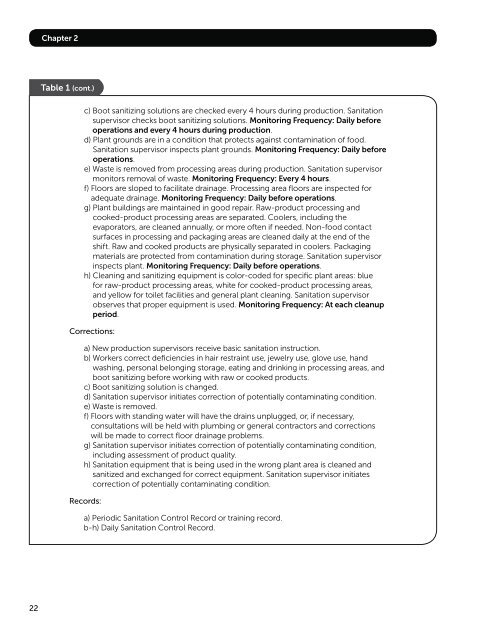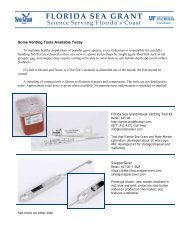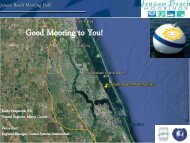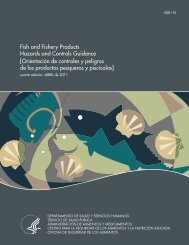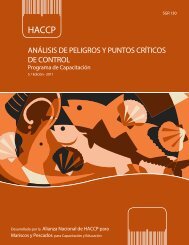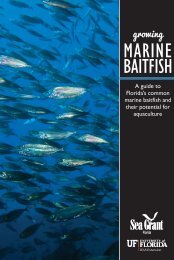HACCP
Hazard Analysis and Critical Control Point - Florida Sea Grant
Hazard Analysis and Critical Control Point - Florida Sea Grant
- No tags were found...
Create successful ePaper yourself
Turn your PDF publications into a flip-book with our unique Google optimized e-Paper software.
Chapter 2<br />
Table 1 (cont.)<br />
c) Boot sanitizing solutions are checked every 4 hours during production. Sanitation<br />
supervisor checks boot sanitizing solutions. Monitoring Frequency: Daily before<br />
operations and every 4 hours during production.<br />
d) Plant grounds are in a condition that protects against contamination of food.<br />
Sanitation supervisor inspects plant grounds. Monitoring Frequency: Daily before<br />
operations.<br />
e) Waste is removed from processing areas during production. Sanitation supervisor<br />
monitors removal of waste. Monitoring Frequency: Every 4 hours.<br />
f) Floors are sloped to facilitate drainage. Processing area floors are inspected for<br />
adequate drainage. Monitoring Frequency: Daily before operations.<br />
g) Plant buildings are maintained in good repair. Raw-product processing and<br />
cooked-product processing areas are separated. Coolers, including the<br />
evaporators, are cleaned annually, or more often if needed. Non-food contact<br />
surfaces in processing and packaging areas are cleaned daily at the end of the<br />
shift. Raw and cooked products are physically separated in coolers. Packaging<br />
materials are protected from contamination during storage. Sanitation supervisor<br />
inspects plant. Monitoring Frequency: Daily before operations.<br />
h) Cleaning and sanitizing equipment is color-coded for specific plant areas: blue<br />
for raw-product processing areas, white for cooked-product processing areas,<br />
and yellow for toilet facilities and general plant cleaning. Sanitation supervisor<br />
observes that proper equipment is used. Monitoring Frequency: At each cleanup<br />
period.<br />
Corrections:<br />
a) New production supervisors receive basic sanitation instruction.<br />
b) Workers correct deficiencies in hair restraint use, jewelry use, glove use, hand<br />
washing, personal belonging storage, eating and drinking in processing areas, and<br />
boot sanitizing before working with raw or cooked products.<br />
c) Boot sanitizing solution is changed.<br />
d) Sanitation supervisor initiates correction of potentially contaminating condition.<br />
e) Waste is removed.<br />
f) Floors with standing water will have the drains unplugged, or, if necessary,<br />
consultations will be held with plumbing or general contractors and corrections<br />
will be made to correct floor drainage problems.<br />
g) Sanitation supervisor initiates correction of potentially contaminating condition,<br />
including assessment of product quality.<br />
h) Sanitation equipment that is being used in the wrong plant area is cleaned and<br />
sanitized and exchanged for correct equipment. Sanitation supervisor initiates<br />
correction of potentially contaminating condition.<br />
Records:<br />
a) Periodic Sanitation Control Record or training record.<br />
b-h) Daily Sanitation Control Record.<br />
22


